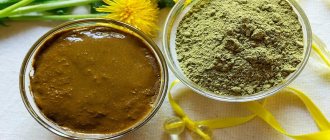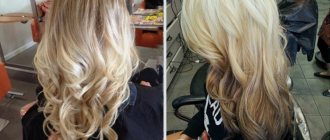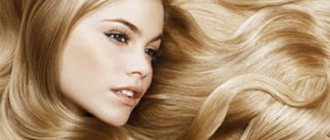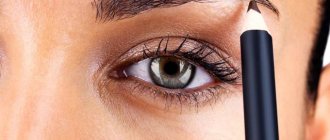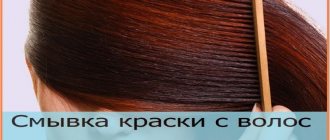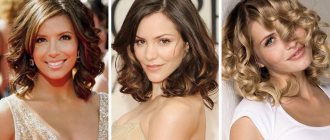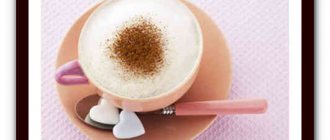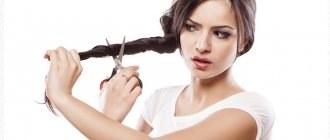How to cook and how to dye your hair with henna
Usually, to dye medium-length hair at home, one standard sachet of the substance is enough. Dilute it in very hot water, adding little by little for coloring until it reaches a creamy consistency. Before applying to the hair, leave the mixture for ten minutes. To keep it from cooling down, keep it in a hot water bath.
Before dyeing, the curls should be washed, dried and combed thoroughly. The ideal option is to trim the ends before dyeing. A rich cream is applied along the hairline to prevent skin coloring. The procedure begins from the forehead. It is recommended to carry out the staining procedure with gloves. Henna strongly eats into the skin and nails, and it is impossible to wash them for at least two days. True, this does not harm the condition of the hands, but they look unaesthetic.
The mass of clean hair is divided by parting into parts of one and a half centimeters and the dye mass is quickly distributed over the hair until the dye has cooled. After dyeing all the strands, the head is wrapped in film with a warm scarf. How long to keep? The length of time that henna is left on the hair will determine the initial tone, thickness and desired outcome of the hair color. If the color is too dark, apply vegetable oil to the locks, massage it in and wash the locks with shampoo. The oil draws out excess henna. Castor bean oil is especially effective.
Dark hair can be dyed in shades from golden to reddish. The paint should be allowed to sit for between a quarter of an hour and an hour and a half. Light brown hair will become brighter.
Blondes need to be careful when dyeing with henna. The shade appears quickly. It only takes five minutes to paint it golden. Therefore, the painting procedure cannot be left without control. The effect on bleached hair is unpredictable, so it is better to refrain from using it yourself. For greater convenience, when applying the mixture to strands at home, it is useful to add yolk to it. It additionally nourishes curls. Natural ingredients change the shade of hair. So, herbal decoctions and kefir give a golden tone.
Coffee, cocoa, black tea or buckthorn are suitable for brown coloring. Onion skins, cloves, hibiscus, red wine or cranberry juice will add redness. A composition with chamomile infusion, cinnamon or ginger will dye the strands golden.
How to increase tone saturation
For rich shades, add an acidic substance to the powder, for example, lemon, yogurt, or essential oils. To twenty grams of water add grams of citric acid and ten grams of henna. The composition is mixed and allowed to brew. This additive releases the coloring pigment. At forty degrees, release will take about three minutes. If the temperature is not higher than thirty degrees, then you can dye the strands only after four hours.
You can squeeze four hundred milliliters of lemon juice per fifty grams of powder and keep it for ten hours. The paint matures faster in a warm place, but it is recommended to warm it up and stir it regularly. Of the esters, geranium, tea tree, lavender, cypress and Ravensar work best. For twenty grams of powder, only a couple of drops are needed.
Rules for dyeing with henna
Negative reviews about painting at home are associated with errors in the use of vegetable paint. Low-quality henna will ruin your hair, as manufacturers enhance the effect of the powder with various additives. Therefore, you should purchase paint only from trusted places and do not chase the cheapest price. And the best options are to paint with high quality Iranian or Indian henna.
High-quality paint can only be purchased in a specialized store. Be sure to look at the ingredients: any additives in the composition are a signal to refuse the purchase. The high-quality product exudes a strong herbal aroma and has a green color. Be sure to test possible shades so as not to make a mistake with the tone saturation. An excessively bright tone will ruin your appearance rather than enhance it.
You can apply henna no more than once every two months. When mixing the product with other paints, the results may be sad rather than encouraging. For the first coloring, it is prudent to go to a salon. Professionals will choose the right tone and teach you how to use it correctly. After evaluating the result and obtaining the necessary information, you can dye your hair on your own.
If the determination to use a natural dye is not enough, you can start with special coloring shampoos containing henna or try colorless henna. The latter will not be able to color the strands, but it will strengthen them, giving a healthy shine. The choice of drug is carried out according to the availability and purpose of the drug. But you should remember that you cannot save on your own beauty.
Let's sum it up
If you have a lot of damaged, split ends or “burnt” hair, as well as those with wheat tones, you should be careful in choosing the color scheme. The effect may not be as expected: a less uniform or brighter color. But you can definitely change the image!
The use of henna both as a dye and as a means to restore hair structure and treat the scalp is very popular among the fair sex. Masks made from colorless henna are used even by representatives of the stronger half of humanity. The result of using this product is shiny, thick and healthy curls.
The procedure is available to everyone; for this it is not necessary to go to an expensive salon and spend fabulous sums. It can be easily done at home. The product is completely natural and affordable, does not harm health and does not cause allergic reactions. It’s up to you to use it to get golden curls or just to improve your health.
Beneficial properties of henna for hair
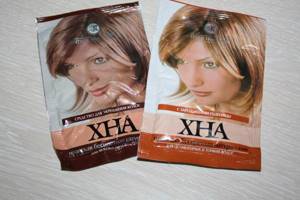
The beneficial properties of henna were discovered a long time ago, so that even ancient beauties used it as a cosmetic product for coloring and tinting their hair. The magical effect of henna is explained by its miraculous composition:
- green chlorophyll is one of the dyes that make up henna, which has a rejuvenating and tonic effect;
- yellow-red lawson (chennotannic acid) is the second dye in henna, which has excellent antifungal and antibacterial properties for the scalp, makes hair stronger, thicker, softer and more voluminous, and effectively eliminates dandruff;
- resinous substances restore hair without weighing it down: thanks to resins, after use for dyeing hair with henna, it remains so light and airy;
- tannins strengthen hair roots, preventing hair loss;
- polysaccharides are a natural hair conditioner that actively moisturizes the scalp and prevents dryness and brittle hair;
- organic acids reduce hair greasiness, normalizing the activity of glands located in the scalp;
- pectin substances give the hair the effect of additional volume, so henna for hair is recommended primarily for those who have dull, thin and lifeless hair;
- Vitamin C, being a natural antioxidant, has a rejuvenating effect on the scalp, which has a beneficial effect on the general condition of the hair;
- Vitamin K promotes rapid hair growth;
- Essential oils for hair and scalp have a healing and restorative effect.
So you can believe those who claim that henna for hair is an excellent natural dye that can not only effectively change the color of your hair, but also provide maximum care to your hair and scalp. With proper coloring you can get amazing results:
- the hair color will become radiant, bright, beautiful and natural - even strangers on the street will be delighted by the shine of henna-dyed hair;
- hair will become stronger, brittleness and dryness will disappear;
- the volume that your hair lacked before will appear;
- you won’t need to collect your own hair from pillows and combs: hair loss will stop;
- the scalp receives additional nutrition, is refreshed, and begins to breathe under the influence of chlorophyll;
- dandruff will disappear.
Henna comes in different varieties - black, white, red
Depending on the country of origin, henna can be Iranian, Indian or Sudanese; this is not only reflected in the barcode, but also in the variety of shades.
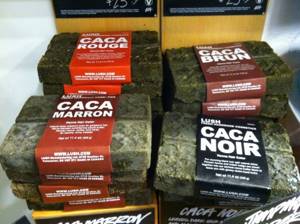
Henna from Lush is presented in four shades: black, red, brown, chestnut (price - from 860 rubles)
Indian
Henna, which originates from India, is available in 5 shades:
- Golden – suitable for blondes and those with light brown hair. Golden tints in curls can be enhanced with the help of additional ingredients, for example, aromatic turmeric or cinnamon.
- Brown is a suitable shade for those whose hair is called light brown or light brown. In combination with turmeric it gives an attractive warm milk chocolate color.

Henna for chocolate-colored hair from PhytoCosmetic
- Burgundy - the name speaks for itself; the noble wine shade is suitable for representatives of the autumn and winter color types. By adding a small amount of beet juice to the coloring mixture, you will get a ripe cherry shade.
- Mahogany , a color known as mahogany or mahogany, has hints of gold and pink at the same time. Suitable for those with natural chestnut color.
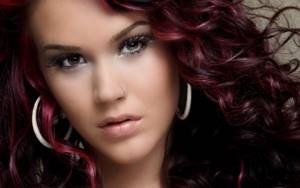
Indian henna in mahogany shade
- Black - to be fair, it is worth noting that when painting you will not get a rich shade of a crow feather, all you can count on is a rich dark chestnut with hints of dark chocolate.
Iranian

Iranian henna allows you to get bright sunny red hair color
Unfortunately, henna, which comes from Iran, has only one shade, which allows you to achieve rich red hair color. However, do not rush to be sad, this particular type of henna combines perfectly with additional natural ingredients, allowing you to get the whole palette from discreet caramel to rich chocolate.

To obtain different shades, Iranian henna is combined with aromatic spices, herbal decoctions and natural juices.
| Natural ingredients | Coloring result | Additional action |
| coffee | rich dark chestnut | Helps strengthen roots and makes hair shiny. |
| nutmeg | dark chocolate | Strengthens roots, improves blood circulation and hair growth. |
| walnut shell | dark brown | It is recommended to use in combination with avocado oil; the duo perfectly moisturizes curls. |
| oak bark decoction | brown | Allows you to get rid of excessive oily scalp. It is recommended to add almond or grape seed oil to the composition. |
| cinnamon | auburn | Improves blood circulation, stimulating hair growth. |
| onion peel decoction | ocher | Strengthens roots. |
| turmeric | golden | Restores damaged hair shaft structure. |
| decoction of orange and tangerine peel | yellow-orange | Recommended for combating excessive oily hair. |
| chicory | creamy golden | Strengthens roots during seasonal loss. |
| red wine, cranberry and beet juice | ruby | Saturates hair with vitamins from outside. |
| elderberry juice | plum | Enriches curls with vitamin A1 and C. |
| ginger, essential oil of parsley, Florentine iris | light red | Strengthens roots and is an excellent prevention of hair loss. |
| tea tree essential oil | light red | Effectively fights dandruff and irritation on the scalp. |
| decoction of dandelion root, horseradish, bearberry leaves, chamomile, water lily | warm wheat shade | Nourishes hair, strengthens roots, gives natural shine. |
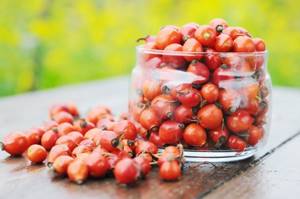
Rosehip decoction perfectly fixes the color obtained with henna; lemon juice has a similar effect.
Advice! To fix the color obtained with henna, it is recommended to dilute the composition with a decoction of sage or rose hips. Additionally, it will help prevent dandruff.
In the homeland of henna, it is extremely rarely used solo; the composition must include essential or base oils: adding shine - cedar; hair restoration – pumpkin; moisturizing – macadamia oil; strengthening – jojoba and peach.
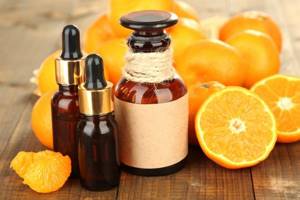
When adding oils, choose those that can solve a number of hair problems: get rid of dandruff, moisturize or help fight hair loss
Sudanese
Sudanese professional color hair henna comes from Saudi Arabia. A simple greenish powder allows you to get a beautiful copper shade that retains its brightness and saturation for a long time. Photo
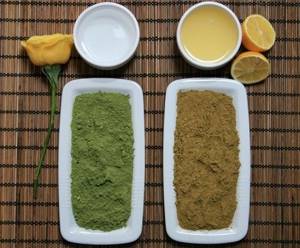
henna and basma, which in duet allow you to get a whole palette of bright, saturated colors
Sudanese henna is often combined with the well-known basma, which also belongs to the category of natural dyes.
Hair color after henna and basma depends on several factors:
- Duration of coloring . The longer the exposure time, the darker and more saturated the color.
- Temperature regime . The warmer the coloring composition, the faster the color change process occurs.
- Initial hair shade . The lighter your curls, the brighter the coloring result will be.
- Hair structure and thickness . Damaged and thin curls are colored much faster. Changing color with Sudanese henna and basma is carried out in two ways. The first involves preparing a mixture of two plant components, the second is a two-level dyeing process, first with henna and then with basma.
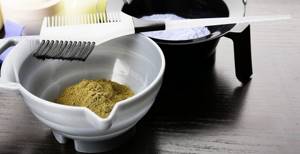
The instructions for preparing the coloring mixture prohibit steaming henna with boiling water, this leads to the release of toxic esters
Note! Coloring together gives a warmer tone in red, brown, chestnut and chocolate shades. A gradual color change in two stages allows you to get cold, ashy tones.
| Original color | Pure henna | Colorless and colored henna (1:1) | Henna and basma (1:2) | Henna and basma (1:1) |
| gray, light | bright light red | strawberry blonde | dark brown | medium brown with copper undertones |
| light brown | bright red | light coppery red | medium brown | |
| redheads | rich red | tone enhancement | light chestnut | |
| medium brown-haired medium blond | medium red | ginger | chestnut | |
| dark brown-haired light brown | dark copper | light red | dark copper chestnut | |
| black | black with copper tint | tone enhancement | dark chestnut | warm black |
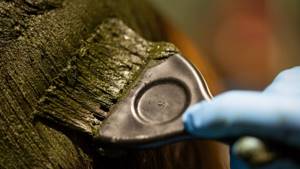
When dyeing yourself, take care to protect your skin.
The shade obtained as a result of separate dyeing depends on the time of exposure to henna and basma.
| Coloring result | Henna | Basma |
| Light brown | 1 hour | 20 minutes |
| Dark chocolate | 1 hour | 40-50 minutes |
| Ash black | 40 minutes | 2 hours |
What types of henna are there?
There are several types of henna for hair coloring, which you should familiarize yourself with before the procedure:
- by purpose: colored henna dyes hair in different shades, while colorless henna only strengthens it, makes it shiny and healthy;
- by origin: the most accessible is Iranian, but Indian henna is no worse; With the help of Yemeni and Sudanese specialists, they not only dye hair, but also apply incredibly beautiful designs to the body.
Choose henna strictly according to its intended purpose and the means available to you. Remember that you shouldn’t skimp on your beauty, so it’s better to initially purchase real, high-quality henna powder and get the desired shade and effect.
General description of the dye
Henna is a green powder obtained by grinding the leaves of the Lawsonia shrub. A plant with a specific odor grows in the regions of the central East and northern Africa.
It contains the following natural components:
- chlorophyll;
- polysaccharides;
- resins;
- hennonatinic acid;
- pectins;
- essential oils and vitamins.
Due to the high concentration of coloring pigment, local residents use it not only for hair coloring, but also for tattooing and fabric dyeing.

It is not necessary that after dyeing the result will be bright red hair color. Using all kinds of additives and changing the henna exposure time, you can dye your curls in different colors (brown, golden, reddish, etc.).
How to prepare paint for coloring?

To release the active substance of the red-yellow dye, you need to mix the powder with a moderately acidic liquid. This will make the color more saturated and stable. For example, you can mix henna or a mixture of henna and basma with lemon or orange juice, wine or vinegar, or slightly acidic herbal tea.
It is not recommended to mix natural dyes with yogurt and other fermented milk products, since the proteins in their composition absorb the color and interfere with the release of the dye from the powder. It is also worth bearing in mind that when you add coffee, the color will become darker, but your hair will smell bad, which can cause an unpleasant headache. Clove powder also enhances color, but often causes irritation.
If you don’t like the smell of henna or basma, you can add a spoonful of dry cardamom or ginger to the mixture so that your hair emits a delicious aroma. If your hair is damaged or dry, you can add 2 tbsp. olive oil. If you want to get a fiery orange color, then dilute henna with boiling water.
Hair coloring methods
Depending on the natural color of the hair and its structure, in each individual case a different shade may be obtained, even if identical proportions of mixing the powder with other components are observed. For example, when applying henna to dark hair, only shine and a reddish tint may appear, but when dyeing blonde hair, the color may become bright red.

Henna coloring without additives
The powder is poured with hot water (80 - 90 degrees), and it must be stirred constantly. Having brought the pulp to the consistency of sour cream, it should be covered and allowed to brew in a warm place for a quarter of an hour. If your hair is dry and brittle, you can add an egg yolk and a spoonful of cream to soften it. It is recommended to apply henna while hot, as cooling reduces the coloring ability.
The mass is applied in the usual way: using a comb with a spout, the strands are distributed, onto which the mixture is applied in layers. For a uniform shade, coloring must be done quickly. To retain heat after wetting the entire head of hair, you can put a regular plastic bag on your head and wrap it with a towel on top.
Depending on the desired color, hair structure and initial shade, the exposure time can vary from 5 - 10 minutes (to obtain a golden hue) to 1 - 2 hours (to give rich color to dark hair). For a more intense shade, henna can be left on the hair overnight.
The dye should be washed off with warm water without using shampoo. You can use a conditioner to remove small pieces of powder. After the procedure, it is not recommended to wash your hair for 2–3 days, since the fixation of natural dye occurs more slowly than chemical dye.
Henna dyeing with basma
When dyeing curls, you usually get reddish, golden shades. If you want to get a chestnut or dark brown color with a golden tint, henna can be combined with basma. Depending on the amount of additive, you can get hair colors from light brown to black.
To obtain a black color, henna is first applied to the strands according to the method described above, after it is washed off, basma is used, also brought to the consistency of a paste using hot water. As a result of dyeing, the hair will acquire a rich black color. The same effect can be achieved by mixing henna and basma together in a 1:2 ratio.
To obtain a light brown shade, henna and basma should be mixed in a ratio of 1:3. You need to keep the mixture on your head for no more than an hour. If the exposure time is increased to 1.5 hours, you can get a chestnut shade. If you want to obtain a bronze shade, henna and basma are mixed in a 2:1 ratio.

Coloring with herbal additives
Depending on the desired shade and hair structure, you can add various herbal additives to henna, according to the following recipes:
- henna with kefir is suitable for dry, long, curly hair. In this case, instead of water, a fermented milk product is used to dilute the powder. Before application, you can additionally add basma, cocoa, coffee. The resulting mass must be slightly warmed, then applied to the hair according to the instructions;
- to give your curls a chocolate tint, the coloring powder can be mixed with freshly brewed coffee grounds or cinnamon;
- to obtain a golden hue, you can prepare a decoction of chamomile, mix it with powder, or mix henna with turmeric or saffron in a 1:1 ratio;
- The red color is obtained by combining the powder with hibiscus tea, cranberry or beet juice, and red wine.
It is important to understand that it is such a permanent dye that after using it it is impossible to dye your hair a different color yourself. Therefore, if you urgently need to change your appearance, it is better to contact a professional hairdressing salon.
How to dye your hair with henna yourself?

Before you start coloring with natural dyes, to find out what color you will get in the end, you need to do a test. To do this, you need to take a small strand of hair from the neck area, apply a little dye, wrap the curl with film and leave for 2-3 hours. Then you need to wash the strand, dry it, wait a few days for the color to settle and evaluate the result. If you are not satisfied with it, then experiment with proportions and additives.
If you are completely satisfied with the test result, then you can start coloring your hair at home:
- Cover the collar area with polyethylene or an unnecessary towel, and put on gloves.
- Hair must be washed first.
- Along the hair growth on the forehead, neck, behind the ears and the ears themselves should be covered with any cream to protect the skin from pigmentation.
- The hair should be divided into small strands of 2-3 cm.
- The mixture is applied to clean, dry or damp hair, but the dye is better absorbed into damp strands.
- Using a brush, apply the product from the roots to the ends of each curl. If after applying the paint to all the strands, the mixture remains, then distribute it over the entire length.
- Put a film or plastic cap on your head and insulate it with a towel on top. When painting only with basma, there is no need to cover it.
- Then you need to wait some time. To obtain light shades, you will have to wait 30-40 minutes in a warm place or 50-60 minutes at room temperature. Darker shades will require 45 to 80 minutes. If your hair is long, then 120 minutes. If only basma was used, then you need to stock up on napkins, since basma flows.
- After the set time has passed, you need to wash each strand with plenty of water, and then the entire head of hair using shampoo and hair conditioner.
- Then the hair is dried, combed and styled.
- The hairstyle will get its usual structure and stable color after the third wash.
What you need to know when using natural dyes
Henna and basma are permanent dyes that do not disappear and are not washed off from the hair. At the same time, over time the color becomes darker, and with each subsequent coloring the hairs will have a more saturated color. After using natural dyes, you can use chemical paint, but the shade will be a little darker (with basma - greener) and will be washed off faster than usual.
Basma dyeing, as a rule, lasts for several months, but gradually acquires a red or blue-violet tint, therefore, in order to maintain the desired color and maintain the shine of the hair, it is necessary to do hair coloring in a timely manner. To renew the coloring, dilute 1 packet of henna or basma in 1 liter of hot water (the proportions can be changed). Carefully filter the solution, cool it and rinse your hair with it.
The harm of natural dyes manifests itself with very frequent use. Due to the content of acids and tannins in henna and basma, they greatly dry out the curls, make them lifeless and dull, and the hairs can begin to split and fall out. Hair oversaturated with these dyes becomes dry, dull and unruly, difficult to style, loses elasticity, becomes stiffer, and is difficult to add volume to.
It is also worth knowing that basma and henna cannot fully match the color of gray hair with the rest of the mass, especially during the first few dyeings. Compared to the rest of the curls, the gray strands look much lighter than the rest, acquiring a carrot tint. For the desired result, you will have to paint over gray hair several times so that the color is completely fixed and becomes uniform.
Some Aspects You Need to Know Before Dyeing Your Hair with Henna
- Henna makes hair heavier ! This is true, so if you dream of voluminous hair, it is best to dye it no more than once every 2-3 months. I dyed my hair every 3 weeks and my hair lost a lot of volume.
- Henna dries out the hair ends a little . I consulted with many fans of henna hair coloring, and some reported that they had not encountered such a problem. Therefore, I make the assumption that it all depends on individual characteristics. However, to avoid drying out, add butter or egg yolk to the mixture. I have tried many oils and can share my opinion. Burdock is too greasy and is difficult to wash out of the hair, and many people notice that it darkens the color. Olive oil moisturizes well, but personally I don’t like its smell on my hair at all. My favorite is coconut oil. It has almost no odor, rinses off well and leaves the hair very soft after using it. Therefore, I recommend mixing it with henna!
- Henna sooner or later gives redness . If you like this hair shade, there is nothing to fear.
If you do not have the courage to dye your hair with this product, purchase coloring shampoos containing this unique natural dye. An even better option is to start with colorless henna, which strengthens your hair and makes it incredibly shiny, but does not give any tint. Now you know what this coloring matter is.
Ways to remove henna from hair
There are several basic masks that can be used to partially or completely get rid of an unsuccessful shade after dyeing your hair with henna.
IMPORTANT! Remember that henna must be washed off immediately after dyeing! After a long time, it will be almost impossible to wash out the coloring pigment from the hair.
- Oil mask. Apply heated olive oil to your hair, wrap it in a bag and a towel and leave for 3-4 hours. Wash off with shampoo.
- Sour cream mask. This mask will help to dull the brightness of the henna color a little. Lubricate your hair with sour cream, wrap it in a bag and a towel, and after an hour wash it off with hair shampoo.
- Alcohol mask. First, gently moisten your hair with alcohol. After about 20 minutes, apply olive, vegetable or cosmetic oil to them. We wrap it in a bag and a towel and periodically warm it with a hairdryer. You can wash off the mask after about half an hour.
